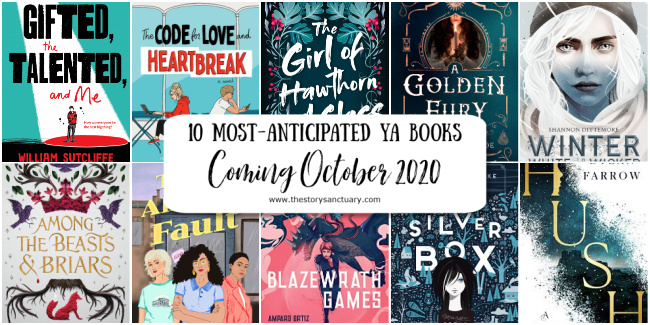
10 Most Anticipated YA Books Coming October 2020
One of the few good things about this year has been that I’ve ended up with a bit more time to read– and thank goodness, because this year has been an incredible one for finding new favorite books.
This month brings even more fabulous titles packed with romance, humor, explorations on social justice and racial issues, and lush fantasy landscapes. Here are a few of the titles I’m most excited about coming out October 2020.
The Girl of Hawthorn and Glass by Adan Jerreat-Poole
Amazon | Barnes & Noble | Book Depository | Indiebound | Goodreads
What you need to know: If you liked NEVERWHERE by Neil Gaiman, you need to read this. Super different story world; I’m on the edge of my seat.
Available October 6, 2020 | My Review
Hush (Hush #1) by Dylan Farrow
Amazon | Barnes & Noble | Book Depository | Indiebound | Goodreads
What you need to know: A feminist fairytale story in a world where words have power and magic is limited to those in control.
Available October 6, 2020
Blazewrath Games by Amparo Oritz
Amazon | Barnes & Noble | Book Depository | Indiebound | Goodreads
What you need to know: Hailed as HOW TO TRAIN YOUR DRAGON meets QUIDDITCH THROUGH THE AGES. Dragon games. Deadly conspiracies. Sounds amazing!
Available October 6, 2020 | My Review
The Code for Love and Heartbreak by Jillian Cantor
Amazon | Barnes & Noble | Book Depository | Indiebound | Goodreads
What you need to know: A contemporary EMMA retelling with a lady math genius and app developer. I can’t wait to read this.
Available October 6, 2020 | My Review
The Silver Box by Margi Preus
Amazon | Barnes & Noble | Book Depository | Indiebound | Goodreads
What you need to know: Francie Frye, a reluctant northwoods Nancy Drew tackles her third mystery and hopes to uncover the truth about her mother. Loved it!
Available October 6, 2020 | My Review
Winter, White and Wicked by Shannon Dittemore
Amazon | Barnes & Noble | Book Depository | Indiebound | Goodreads
What you need to know: Mad Max: Fury Road meets Frozen. (I’m intrigued!) A quest for her missing best friend pairs a girl with a team of unconventional allies.
Available October 13, 2020
This is All Your Fault by Aminah Mae Safi
Amazon | Barnes & Noble | Book Depository | Indiebound | Goodreads
What you need to know: Set over the course of a single day. Follows three women determined to save an indie bookstore.
Available October 13, 2020
The Gifted, the Talented, and Me by William Sutcliffe
Amazon | Barnes & Noble | Book Depository | Indiebound | Goodreads
What you need to know: Irreverent and hilarious. A story about fitting in and staying true to yourself. Sounds like the perfect pick-me-up read!
Available October 13, 2020 | My Review
A Golden Fury by Samantha Cohoe
Amazon | Barnes & Noble | Book Depository | Indiebound | Goodreads
What you need to know: A girl faces a terrible curse in order to save the lives of those she loves. Magic and alchemy. Sounds perfect for fans of GIVE THE DARK MY LOVE and TO BEST THE BOYS.
Available October 13, 2020 | My Review
Among the Beasts and Briars by Ashley Poston
Amazon | Barnes & Noble | Book Depository | Indiebound | Goodreads
What you need to know: A cursed wood encroaching on a peaceful kingdom. A girl who can save it with the help of a pesky fox, a powerful bear, and the magic in her veins. Poston is on my auto-buy list, so I MUST have this one!
Available October 20, 2020
What’s on your October reading list?
Have you read any of the books on my list already? Which books are you looking forward to reading this month?